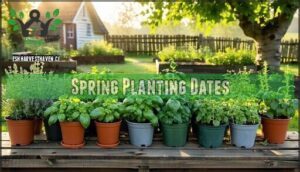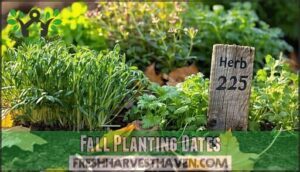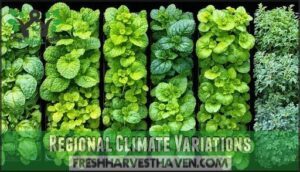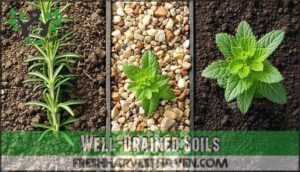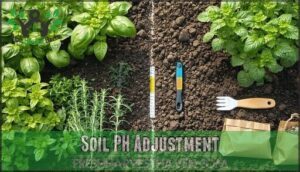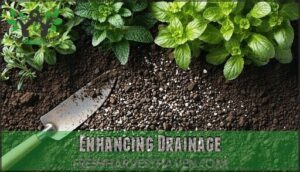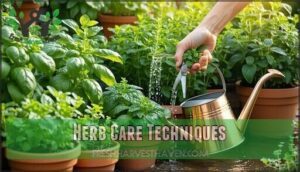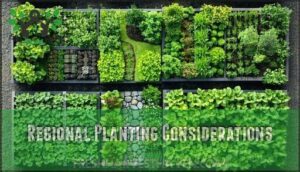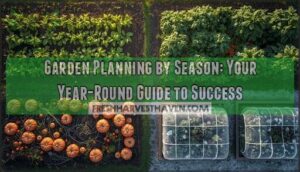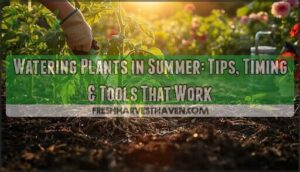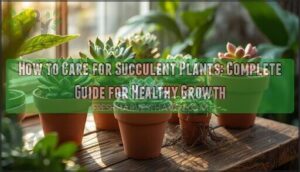This site is supported by our readers. We may earn a commission, at no cost to you, if you purchase through links.
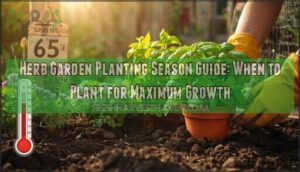 Your herb garden planting season guide starts with soil temperature – wait until it hits 65°F consistently.
Your herb garden planting season guide starts with soil temperature – wait until it hits 65°F consistently.
Most herbs are warm-weather lovers who’ll sulk in cold ground.
Check your last frost date and add two weeks as your safety net.
Spring plantings typically happen between April and June, depending on your location.
Cool-season herbs like cilantro and parsley can handle earlier starts, while basil and oregano need that soil warmth to really take off.
Fall planting works too – six to eight weeks before your first expected frost gives herbs time to establish.
The secret timing tricks that separate thriving gardens from struggling ones involve more than just temperature.
Table Of Contents
- Key Takeaways
- Herb Garden Basics
- Planting Season Guide
- Soil Preparation Tips
- Herb Care Techniques
- Regional Planting Considerations
- Frequently Asked Questions (FAQs)
- What month to start planting herbs?
- Can I plant herbs in September?
- When to plant herbs?
- How do you plant a herb garden?
- When do herbs grow best?
- What is a herb planting chart?
- Should I start my herb garden from seed?
- Are herbs a good addition to the garden?
- . Why Should You Start Seeds indoors?
- . Which Seeds Should You Start indoors?
- Conclusion
Key Takeaways
- Wait until soil temperature hits 65°F consistently before planting warm-season herbs like basil and oregano—they’ll struggle in cold ground and won’t establish properly.
- Use your last frost date plus two weeks as your safety net for spring planting, typically between April and June depending on your location.
- Choose cool-season herbs like cilantro and parsley for earlier starts, as they can handle cooler conditions while warm-weather varieties need that soil warmth.
- Plan fall plantings six to eight weeks before your first expected frost to give herbs time to establish strong roots before winter.
Herb Garden Basics
Starting your herb garden becomes easier when you choose beginner-friendly varieties like chives, basil, and mint that forgive mistakes and reward you with quick growth.
You’ll want to match each herb’s specific needs—most prefer well-drained soil and 6-8 hours of sunlight, though some like parsley tolerate partial shade.
Easy to Grow Herbs
Starting your herb garden doesn’t have to feel overwhelming—these easy-to-grow varieties will turn you into a green-thumb master.
With these beginner herbs, success is simple and your kitchen will never be without fresh flavor.
These beginner-friendly herbs thrive with minimal fuss and deliver maximum flavor.
- Chives: Plant seeds ¼" deep in wet soil for foolproof germination
- Basil: Start seeds indoors 6-8 weeks before last frost for best results
- Mint: Hardy perennial that grows up to 3 feet with proper spacing
- Parsley: Soak seeds overnight to improve germination rates substantially
- Dill: Direct outdoor planting in sunny locations with generous watering
Herb Variety Selection
Your herb choices shape your garden’s success throughout the growing season.
Smart plant diversity guarantees continuous harvests and natural pest control through strategic crop rotation. Consider your cooking preferences when making seed selection decisions for garden planning.
Understanding summer herb gardening is vital for a thriving herb garden.
| Beginner-Friendly Herbs | Advanced Varieties |
|---|---|
| Chives, Basil, Mint | Dill, Parsley, Cilantro |
| Quick germination | Longer establishment |
| Forgiving growth habits | Specific timing needs |
Soil Type and Light Requirements
Through proper soil texture and drainage systems, you’ll release your herbs’ full potential.
Well-drained soil with neutral pH prevents root rot while supporting healthy nutrient levels.
Most herbs thrive in sandy or loamy soil conditions with six hours of direct sunlight daily.
Light intensity affects essential oil production, so choose locations meeting specific sunlight requirements.
Monitor soil temperature for ideal germination timing, as it is crucial for the healthy development of your herbs, and ensure you provide the right conditions for them to reach their full potential with proper soil texture.
Planting Season Guide
Timing your herb plantings correctly means the difference between a thriving garden and struggling seedlings.
You’ll need to understand your local frost dates and seasonal patterns to maximize growth and harvest potential.
Spring Planting Dates
Timing your herb planting season right means understanding your last frost date and climate zones.
Start seed starting indoors 6-8 weeks before final frost, typically late February through March.
Direct sow hardy herbs like chives and parsley mid-April, while tender varieties need warm soil prep until mid-May when temperatures reach 60°F consistently.
To maximize growth, consider herb pairing strategies when planning your garden layout to ensure the best results for your herb garden with proper climate zones understanding.
Fall Planting Dates
Fall planting dates reveal your herb garden’s potential for cool season success.
Plant hardy herbs like parsley, chives, and cilantro 6-8 weeks before your area’s first frost date.
These cool weather champions actually prefer fall sowing since they’ll establish strong roots before winter dormancy.
Check your local frost dates and count backward for perfect harvest timing throughout autumn.
Regional Climate Variations
Across different USDA Planting Zones, you’ll encounter dramatic Weather Patterns that reshape your herb garden strategy.
Temperature Fluctuations between Climate Zones create unique challenges, while Regional Microclimates add another layer of complexity to your gardening guide.
- Zone 3-4: Short 135-160 day seasons demand quick-maturing herbs
- Zone 9-10: Extended 310+ day growing periods enable multiple harvests
- Southern humidity requires spaced plantings for airflow
- Northern frost dates dictate protective cover timing
Understanding Seasonal Shifts helps you master regional climate variations effectively. To adapt to these changes, consider climate change impacts on your herb garden’s overall health and resilience. This will help you navigate the challenges of Regional Microclimates and Temperature Fluctuations.
Soil Preparation Tips
Your soil’s foundation determines whether your herbs thrive or merely survive through the growing season.
Proper drainage and pH balance create the ideal environment for robust herb growth and maximum flavor concentration.
Well-Drained Soils
Most herbs thrive in well-drained soil that prevents waterlogged roots.
You’ll achieve ideal drainage by adding pine bark, pea gravel, or coarse compost to your planting area.
Rocky terrain naturally provides excellent water table management, while raised beds solve drainage issues in heavy clay soils.
Proper soil preparation involves understanding ideal soil composition basics to create a thriving environment for herbs.
| Soil Amendment | Drainage Benefit | Application Rate | Best For | Cost Level |
|---|---|---|---|---|
| Pine Bark | Improves structure | 2-3 inches mixed | Heavy clay soils | Low |
| Pea Gravel | Prevents waterlogging | 1-2 inches layer | Bottom drainage | Medium |
| Coarse Compost | Enhances cultivation | 25% soil mix | General improvement | Low |
| Sand | Quick water movement | 20% soil blend | Fast-draining beds | Low |
| Wood Chips | Long-term structure | 3-4 inches mulch | Surface drainage | Low |
The use of these soil amendments can significantly improve the drainage and overall health of your herbs, making them a crucial part of proper soil preparation and herb cultivation.
Soil PH Adjustment
Most herbs thrive in pH 6.0-7.5, requiring pH Testing before planting to guarantee the best nutrient uptake.
Soil Acidity outside this range blocks essential nutrients, stunting growth and reducing yields.
- Apply Lime Addition (7lb/100sqft) to raise acidic soil pH in fall
- Use sulfur or Compost Usage to lower alkaline soil gradually
- Maintain Fertilizer Balance by retesting soil after amendments settle
For accurate results, regular soil test checks are necessary to monitor pH levels and adjust accordingly.
Enhancing Drainage
Transform your herb garden by breaking up compacted soil with gravel mulch and drainage materials.
Add coarse compost, sand, or pea gravel to boost soil porosity and prevent waterlogged roots.
Well-drained soil cultivation keeps your water table balanced, ensuring proper soil aeration.
Your herbs will thrive when excess moisture can’t drown their delicate root systems in soggy conditions.
Effective gravel mulch systems require understanding of gravel mulch benefits to enhance soil quality and ensure your herbs receive the right amount of water, making them thrive in a balanced environment with proper soil aeration.
Herb Care Techniques
Once you’ve planted your herbs, proper care guarantees healthy growth and abundant harvests throughout the growing season.
You’ll need to master three key techniques: consistent watering without overdoing it, strategic harvesting to encourage new growth, and identifying common pests before they damage your plants.
Watering and Fertilizing
Proper soil moisture management prevents both drought stress and root rot in your herb garden.
Check soil conditions daily by inserting your finger two inches deep—water when dry. Use balanced fertilizer types sparingly, as most herbs prefer lean soil.
Install irrigation systems for consistent water quality and nutrient balance in well-drained soil.
Effective herb fertilizer applications require understanding herb fertilizer options to promote healthy plant growth.
Harvesting and Pruning
Once your herbs mature, timing your harvesting becomes critical for peak flavor and growth.
Cut herbs in the morning after dew dries but before afternoon heat sets in. Use sharp pruning tools for clean stem cutting that won’t damage plants.
Regular leaf pruning encourages bushier growth and prevents flowering, which can make leaves bitter. Harvest frequently to maintain productive herb garden growth throughout the season.
Understanding proper harvesting methods is essential for maximizing the yield and flavor of your herbs.
Common Herb Pests
Your carefully tended herb garden can become a battleground when unwelcome visitors arrive.
Aphid control starts with regular pest inspection—check leaf undersides weekly for these tiny green invaders.
Whitefly management requires immediate action when you spot clouds of white insects around oregano and thyme.
Organic solutions like neem oil provide effective fungus prevention while protecting beneficial insects.
Early detection through consistent plant care keeps your herbal gardening dreams alive and thriving, which is the key to successful gardening.
Regional Planting Considerations
Your location determines the perfect timing for herb planting success. Different regions require adjusted schedules based on frost dates, growing seasons, and local climate patterns.
Success starts in your backyard with perfect timing and local conditions.
United States Planting Dates
Successful herb planting across US Climate Zones requires understanding your region’s frost dates and seasonal timing.
Southern gardeners can start planting schedules in late February, while northern zones wait until May.
Use regional maps and gardening calendars to determine key windows.
Most herb gardeners rely on these planting guides for garden planting success throughout diverse American growing conditions.
Understanding the hardiness zone concept is essential for choosing the right herbs to plant in your area, considering regional maps and gardening calendars for complete concepts.
Canada Planting Dates
Canadian herb gardeners work with shorter growing seasons across diverse hardiness zones.
Most regions need indoor seed starting 6-8 weeks before frost dates, typically March through April.
Zone 3 areas face last frosts in late May, while Zone 7 regions start outdoor planting mid-April.
Monitor soil temperature reaching 60°F consistently, as regional climates vary dramatically from maritime to prairie conditions.
Localized Climate Variations
Your microclimate matters more than your grow zone suggests.
Geographic elevation and regional weather patterns create unique temperature fluctuations that affect plant growth timing.
Consider these localized climate variations:
- Elevation changes – Higher altitudes delay planting by 1-2 weeks per 1,000 feet
- Urban heat islands – Cities run 2-5°F warmer than surrounding areas
- Coastal influences – Ocean proximity moderates temperature swings year-round
- Valley effects – Low-lying areas collect cold air and frost longer
Smart gardening techniques involve observing your specific microclimate factors rather than blindly following zone maps.
Frequently Asked Questions (FAQs)
What month to start planting herbs?
Start planting herb seeds indoors in February or March, about six to eight weeks before your last frost date. You’ll transplant them outdoors once danger of frost passes.
Can I plant herbs in September?
Yes, you can plant herbs in September! Fall’s cooler weather works great for cool-season herbs like parsley, chives, and cilantro. They’ll establish strong roots before winter hits.
When to plant herbs?
Most herbs benefit from spring planting after the last frost, typically March through May.
You’ll get best germination rates when soil reaches 60-70°F.
Hardy perennials like chives can handle earlier planting, while tender annuals need warmer conditions.
How do you plant a herb garden?
Choose a sunny, well-drained spot and prepare soil with good drainage.
Start with easy herbs like basil, chives, and mint.
Space plants properly, water consistently, and you’ll be harvesting fresh herbs in no time.
When do herbs grow best?
Most herbs thrive during warm growing seasons when soil temperatures reach 65-75°F.
You’ll get peak growth from late spring through early fall, with consistent moisture and 6-8 hours of sunlight daily.
What is a herb planting chart?
Need a roadmap for your garden’s success?
A herb planting chart’s your seasonal calendar showing when to start seeds indoors, transplant outdoors, and harvest each herb based on your local frost dates and growing zone.
Should I start my herb garden from seed?
Starting from seed gives you more variety and costs less, but requires patience. Most herbs like basil and parsley need 6-8 weeks indoors before transplanting. Chives are easiest for beginners.
Are herbs a good addition to the garden?
Good things come in small packages" rings true for herbs – they’re powerhouse additions offering fresh flavors, natural pest deterrence, and medicinal benefits in compact spaces.
They’ll reward your gardening efforts tenfold.
. Why Should You Start Seeds indoors?
Indoor seed starting gives you a head start on the growing season, letting you control temperature and moisture perfectly.
You’ll get stronger seedlings that transplant better, extending your harvest window by weeks.
. Which Seeds Should You Start indoors?
Start basil, parsley, and mint indoors since they need warm conditions to germinate properly. You’ll get stronger seedlings and extend your growing season compared to direct outdoor sowing.
Conclusion
Success doesn’t happen by accident—it follows those who master their herb garden planting season guide.
You’ve got the knowledge to time your plantings perfectly, from soil temperature checks to regional variations.
Remember, warm-season herbs need that 65°F soil warmth, while cool-season varieties tolerate earlier starts.
Whether you’re planting in spring or fall, proper timing transforms struggling seedlings into thriving harvests that’ll keep your kitchen supplied year-round.

